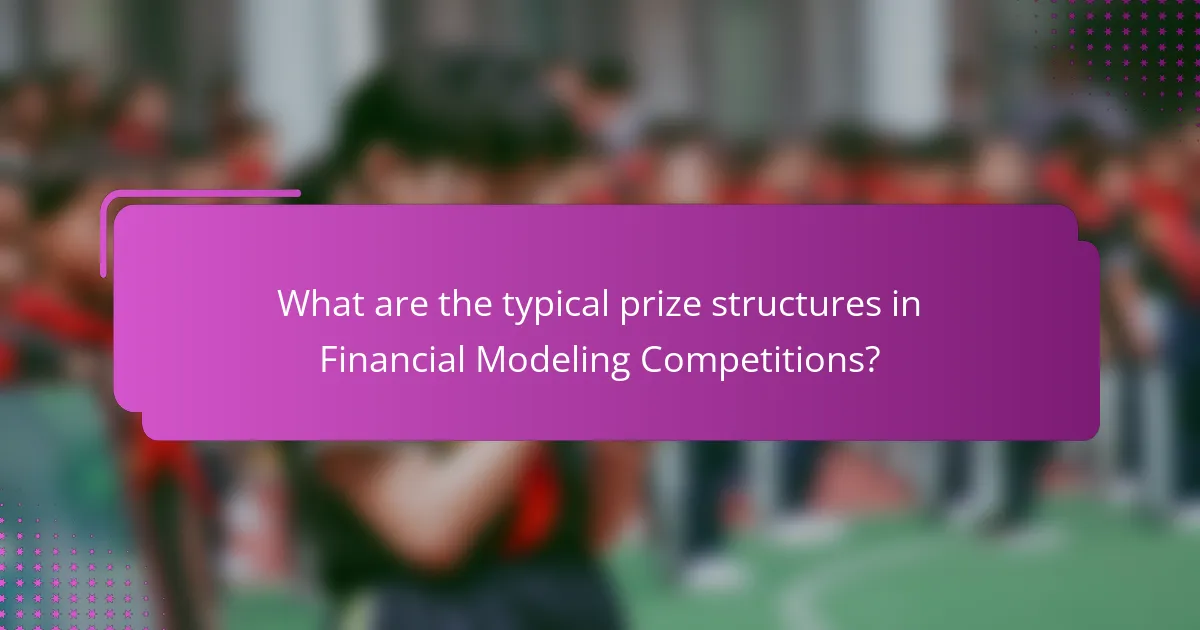Financial modeling competitions are structured events where participants create financial models to address real-world business challenges. These competitions require analytical skills, proficiency in Excel, and effective communication to analyze financial data and present findings. Judging criteria focus on accuracy, clarity, complexity, and creativity, ensuring participants demonstrate their financial modeling capabilities. Prize structures often include cash rewards, scholarships, internships, and recognition awards, incentivizing participation and enhancing career prospects. This overview highlights the essential skills, assessment criteria, and rewards associated with financial modeling competitions.

What are Financial Modeling Competitions?
Financial modeling competitions are events where participants create financial models to solve real-world business problems. These competitions often involve analyzing financial data and making projections based on various scenarios. Participants typically work in teams or individually to develop their models within a specified timeframe. Judging criteria usually include accuracy, creativity, and the ability to present findings effectively. Many competitions are hosted by universities or financial institutions. They provide networking opportunities and can enhance participants’ resumes. Some competitions also offer monetary prizes or internships as incentives.
How do Financial Modeling Competitions operate?
Financial modeling competitions operate by presenting participants with a financial scenario requiring analysis and modeling. Competitors typically receive a case study that outlines the problem and necessary data. They must create a financial model using spreadsheet software to solve the problem. Participants often work individually or in teams to develop their solutions. Submissions are evaluated based on accuracy, creativity, and presentation. Judges, often industry professionals, assess the models against predefined criteria. Prizes are awarded to top performers, which may include cash, internships, or networking opportunities. These competitions enhance participants’ analytical and presentation skills while providing real-world experience.
What are the key stages of a Financial Modeling Competition?
The key stages of a Financial Modeling Competition include registration, preparation, submission, and evaluation. Registration involves participants signing up for the competition. Preparation requires teams to develop their financial models based on provided case studies. Submission is the process of submitting the completed models by the deadline. Evaluation is conducted by judges who assess the models based on criteria like accuracy, creativity, and presentation. These stages ensure a structured approach to the competition and facilitate fair assessment of participants’ skills.
Who participates in Financial Modeling Competitions?
Students and professionals in finance participate in Financial Modeling Competitions. These participants often include undergraduate and graduate students from business schools. Many professionals from finance-related fields also engage in these competitions. Participants typically possess skills in financial analysis, modeling, and valuation. Competitions attract individuals with backgrounds in accounting, economics, and quantitative disciplines. They often seek to enhance their practical skills and gain recognition in the finance industry. Some competitions are specifically designed for university teams, while others are open to individual competitors. Overall, the participant pool is diverse, reflecting various educational and professional experiences in finance.
Why are Financial Modeling Competitions important?
Financial modeling competitions are important because they enhance participants’ analytical and technical skills. These competitions simulate real-world financial scenarios, requiring participants to create robust financial models. They provide practical experience in data analysis, forecasting, and valuation techniques. Participants also learn to work under pressure and meet tight deadlines. Networking opportunities arise, connecting students with industry professionals and potential employers. Competitions often attract sponsorships from financial firms, offering exposure to real-world practices. According to a study by the CFA Institute, 70% of participants reported improved job prospects after competing. Such events foster a competitive spirit, encouraging innovation and collaboration among peers.
What skills do participants develop through these competitions?
Participants develop analytical skills through financial modeling competitions. These competitions require critical thinking to solve complex financial problems. Participants also enhance their proficiency in financial analysis and valuation techniques. They learn to create and interpret financial models effectively. Additionally, teamwork skills are fostered as participants often collaborate in groups. Time management is crucial, as deadlines are typically tight. Participants also improve their presentation skills by showcasing their models to judges. Finally, adaptability is developed as competitors must adjust to feedback and new challenges.
How do these competitions impact career opportunities?
Financial modeling competitions significantly enhance career opportunities for participants. These competitions provide practical experience that is highly valued by employers. Participants develop essential skills such as analytical thinking and problem-solving. These skills are crucial in finance and related fields. Success in competitions often leads to networking opportunities with industry professionals. Many companies actively recruit from competition participants. Statistics show that over 60% of winners receive job offers from sponsors. Additionally, recognition from competitions boosts a candidate’s resume and marketability. This combination of skills, networking, and recognition creates a strong advantage in the job market.

What key skills are essential for success in Financial Modeling Competitions?
Analytical skills are essential for success in Financial Modeling Competitions. Participants must interpret financial data accurately. Strong quantitative skills enable competitors to perform complex calculations. Proficiency in Excel is critical for building models efficiently. Attention to detail helps in identifying errors and ensuring accuracy. Communication skills are necessary to present findings clearly. Teamwork abilities enhance collaboration among participants. Lastly, time management is crucial to meet tight deadlines during competitions.
What technical skills are required for Financial Modeling Competitions?
Financial modeling competitions require proficiency in Excel, financial analysis, and valuation techniques. Participants must be adept at using Excel functions and formulas for data manipulation. Knowledge of financial statements is essential for accurate analysis. Skills in forecasting and budgeting are crucial for creating realistic models. Understanding valuation methods, such as DCF and comparables, is necessary for assessing investment opportunities. Familiarity with data visualization tools enhances the presentation of models. Additionally, strong analytical skills help in interpreting complex financial data effectively. These technical skills are fundamental for success in financial modeling competitions.
How do participants enhance their Excel proficiency?
Participants enhance their Excel proficiency through practice, training, and competition participation. They engage in hands-on projects that require advanced Excel functions. Online courses and tutorials provide structured learning paths. Participants also collaborate with peers to share knowledge and tips. Regularly using Excel for financial modeling reinforces their skills. Competitions challenge them to apply their knowledge under pressure. Feedback from judges helps identify areas for improvement. This combination of methods leads to significant skill enhancement.
What financial analysis skills are crucial for competitors?
Competitors in financial modeling competitions require strong analytical skills. These skills include proficiency in financial statement analysis, which helps in evaluating a company’s performance. Competitors must also be adept at forecasting, enabling them to predict future financial outcomes based on historical data. Mastery of valuation techniques is crucial for determining a company’s worth accurately. Furthermore, competitors should possess strong Excel skills for efficient data manipulation and modeling. Knowledge of accounting principles is essential for understanding financial reports. Effective communication skills are necessary to present findings clearly. Lastly, competitors benefit from critical thinking skills to solve complex financial problems.
What soft skills contribute to success in these competitions?
Soft skills that contribute to success in financial modeling competitions include teamwork, communication, and adaptability. Teamwork is essential as participants often collaborate in groups to develop models. Effective communication allows team members to share ideas and present their findings clearly. Adaptability is crucial for responding to changing competition requirements or unexpected challenges. Research indicates that teams with strong interpersonal skills perform better in competitive environments. A study by the Harvard Business Review found that emotional intelligence, a key soft skill, significantly impacts team performance.
How does teamwork play a role in Financial Modeling Competitions?
Teamwork is essential in Financial Modeling Competitions. It enhances collaboration among team members. Effective teamwork allows for the pooling of diverse skills and perspectives. This diversity leads to more innovative solutions and comprehensive analyses. Teams can divide tasks based on individual strengths. This specialization improves efficiency and productivity. Additionally, teamwork fosters communication, ensuring all members are aligned. Research shows that teams outperform individuals in complex problem-solving tasks. Thus, teamwork significantly impacts performance in these competitions.
Why is effective communication important during competitions?
Effective communication is crucial during competitions as it ensures clarity and understanding among team members. Clear communication helps in the efficient exchange of ideas and strategies. It minimizes misunderstandings that can lead to errors in performance. Effective communication also fosters collaboration, allowing teams to work cohesively towards a common goal. In financial modeling competitions, presenting complex information clearly is essential for judges to evaluate proposals accurately. Studies show that teams with strong communication skills often outperform those with weaker communication. This highlights the direct link between communication effectiveness and competitive success.

What assessment criteria are used in Financial Modeling Competitions?
Assessment criteria in Financial Modeling Competitions typically include accuracy, clarity, and complexity. Accuracy evaluates the correctness of the financial model’s calculations and assumptions. Clarity assesses how well the model presents information and communicates insights. Complexity measures the sophistication of the model, including the use of advanced financial techniques. Additional criteria may involve creativity, presentation quality, and adherence to competition guidelines. These criteria ensure that participants showcase their financial modeling skills effectively.
How are models evaluated in these competitions?
Models in financial modeling competitions are evaluated based on criteria such as accuracy, creativity, and presentation. Accuracy refers to how well the model predicts outcomes based on the provided data. Creativity assesses the uniqueness of the modeling approach and the innovative use of techniques. Presentation evaluates the clarity and professionalism of the model’s documentation and visualizations. Judges often use a scoring rubric to assign points for each criterion. This structured evaluation ensures a fair comparison among participants. Competitions may also include peer reviews as part of the evaluation process.
What are the common scoring metrics used by judges?
Common scoring metrics used by judges include accuracy, clarity, and creativity. Accuracy measures the correctness of financial models and calculations. Clarity assesses how well competitors communicate their ideas. Creativity evaluates the uniqueness of the proposed solutions. Judges may also consider presentation skills and adherence to guidelines. These metrics ensure a comprehensive evaluation of participants’ work. Each metric plays a critical role in determining the final scores.
How does presentation impact the assessment of models?
Presentation significantly impacts the assessment of models in financial competitions. Clear and visually appealing presentations enhance understanding and retention of complex data. Judges often prioritize models that effectively communicate insights through graphs and charts. A well-structured presentation demonstrates professionalism and attention to detail. This can influence judges’ perceptions of the model’s credibility and accuracy. Effective use of visuals can lead to higher engagement and interest from the audience. Research shows that presentations with strong visual elements improve audience recall by up to 65%. Therefore, presentation quality is a crucial factor in the overall assessment of financial models.
What role does creativity play in the evaluation process?
Creativity plays a crucial role in the evaluation process of financial modeling competitions. It allows participants to develop innovative solutions to complex financial problems. Creative approaches can differentiate a model from others by providing unique insights or methodologies. Judges often look for originality in problem-solving as a key criterion. This creativity can manifest in various ways, such as the use of unconventional data sources or novel analytical techniques. For example, a study by the Harvard Business Review highlights that creative solutions lead to better financial decision-making. Thus, creativity not only enhances the quality of financial models but also significantly influences evaluation outcomes.
How can participants showcase innovative solutions in their models?
Participants can showcase innovative solutions in their models by incorporating unique data analysis techniques. They should utilize advanced statistical methods and predictive analytics to enhance their financial forecasts. Visualizations can effectively communicate complex data insights. Interactive elements in models can engage judges and demonstrate user-friendliness. Participants should also highlight real-world applications of their solutions. Presenting case studies or simulations can provide context and validate their approaches. Feedback from industry professionals can further refine their models. These strategies collectively enhance the originality and effectiveness of their financial models.
What examples illustrate creative approaches in past competitions?
Past financial modeling competitions have showcased innovative approaches in various ways. One notable example is the use of real-time data analysis. Participants integrated live market data into their models for accurate forecasting. Another example is the incorporation of machine learning techniques. Teams developed algorithms to enhance predictive accuracy in their financial models.
Additionally, some competitors utilized interactive visualizations. This approach allowed for clearer presentation of complex data. Furthermore, collaboration with industry professionals was common. Many teams sought mentorship to refine their strategies and models. These creative methods not only improved outcomes but also set new standards in financial modeling competitions.

What are the typical prize structures in Financial Modeling Competitions?
Typical prize structures in Financial Modeling Competitions often include cash prizes, scholarships, and internships. Cash prizes can range from a few hundred to several thousand dollars. Scholarships may be awarded to the top performers for further education. Internships or job offers are common incentives provided by sponsoring firms. Additionally, some competitions offer recognition awards, such as certificates or trophies. These prizes aim to motivate participants and acknowledge their skills in financial modeling. Competitions like the CFA Institute Research Challenge exemplify these structures with substantial monetary rewards and career opportunities.
What types of prizes can participants expect?
Participants can expect various prizes in financial modeling competitions. Common prizes include cash awards, scholarships, and internships. Some competitions also offer software licenses or tools relevant to financial modeling. Additionally, winners may receive mentorship opportunities from industry professionals. Recognition through certificates or trophies is often provided as well. These prizes aim to incentivize skill development and professional growth in finance.
How do monetary awards compare to other forms of recognition?
Monetary awards provide tangible rewards that can motivate participants more effectively than non-monetary recognition. Financial incentives can lead to higher participation rates in competitions. Studies show that monetary rewards often correlate with increased effort and performance. In contrast, non-monetary forms of recognition, such as trophies or certificates, may foster pride but lack immediate financial benefit. Research indicates that monetary recognition can enhance overall satisfaction and perceived value of achievements. Furthermore, monetary awards can lead to greater visibility and opportunities in professional settings. This demonstrates that while both forms of recognition are valuable, monetary awards often have a stronger impact on motivation and performance outcomes.
What opportunities arise from winning or placing in competitions?
Winning or placing in competitions provides several opportunities. Participants can gain recognition in their field. This recognition can lead to job offers from industry leaders. Competitions often offer monetary prizes, which can provide financial support. Networking opportunities arise, connecting participants with professionals and mentors. Competitors can enhance their skills through practical experience. Winning can also boost confidence and credibility in the industry. Additionally, it may lead to invitations for speaking engagements or collaborations. These opportunities can significantly impact a participant’s career trajectory.
How do different competitions vary in their prize offerings?
Different competitions vary in their prize offerings based on their structure and sponsorship. Financial modeling competitions often provide cash prizes, scholarships, or internships. For example, some competitions offer prizes ranging from $1,000 to $10,000 for top performers. Others may provide opportunities for mentorship or networking with industry professionals. Additionally, the prestige of the competition can influence prize values. High-profile competitions may attract larger sponsors, resulting in more substantial prize offerings. In contrast, local or smaller competitions typically offer modest rewards. The variation in prizes reflects the competition’s goals and the resources available from sponsors.
What are some notable competitions with unique prize structures?
Notable competitions with unique prize structures include the CFA Institute Research Challenge and the Rotman International Trading Competition. The CFA Institute Research Challenge offers scholarships and mentorship opportunities as part of its prize. Participants can gain insights from industry professionals, enhancing their career prospects. The Rotman International Trading Competition features cash prizes and internships for top teams. This competition emphasizes real-world trading strategies and market analysis skills. Such unique prize structures attract participants and elevate the competition’s prestige.
How do sponsors influence prize distribution in competitions?
Sponsors influence prize distribution in competitions by providing funding and resources. Their financial contributions often determine the total prize pool available. Sponsors may set specific criteria for prize allocation. This can include designating awards for particular achievements or categories. For example, a sponsor might offer a bonus for the most innovative solution. Additionally, sponsors may influence the visibility of certain prizes. This can affect participants’ motivation and focus during the competition. Ultimately, sponsors play a crucial role in shaping the overall prize structure. Their preferences can lead to variations in prize distribution across different competitions.
What tips can enhance performance in Financial Modeling Competitions?
Practice regularly to enhance performance in Financial Modeling Competitions. Familiarity with financial concepts and modeling techniques is crucial. Utilize online resources and courses to build knowledge. Collaborate with peers to gain different perspectives. Time management is essential; practice completing models within competition time limits. Focus on accuracy and attention to detail in your models. Review past competition cases to identify common pitfalls and successful strategies. Lastly, seek feedback from experienced participants to improve your skills.
How can participants prepare effectively for these competitions?
Participants can prepare effectively for financial modeling competitions by mastering key financial concepts and modeling techniques. They should familiarize themselves with financial statements, valuation methods, and forecasting techniques. Practicing with real-world case studies enhances their analytical skills. Participants must also refine their Excel skills, as proficiency is crucial for building models. Joining study groups or online forums can provide valuable insights and resources. Reviewing past competition problems helps in understanding common challenges. Additionally, time management during practice sessions is essential to simulate competition conditions. Engaging in mock competitions can further improve their performance under pressure.
What strategies help in maximizing scores during assessments?
Effective strategies for maximizing scores during assessments include thorough preparation, time management, and understanding assessment criteria. Preparation involves studying relevant materials and practicing financial modeling techniques. Time management ensures that each section of the assessment receives adequate attention. Understanding the criteria helps focus efforts on what evaluators prioritize. Research indicates that students who practice under timed conditions perform better. According to a study by the Educational Testing Service, effective study habits can increase scores by up to 20%. These strategies collectively enhance performance and lead to higher scores.
Financial modeling competitions are structured events where participants create financial models to address real-world business challenges. The article provides an overview of these competitions, detailing their operation, key stages, and participant demographics. It highlights the essential skills required for success, including analytical and technical proficiencies, as well as soft skills like teamwork and communication. The assessment criteria for evaluating models, including accuracy and creativity, are discussed, along with the various prize structures that incentivize participation, such as cash awards and internships. Overall, the article serves as a comprehensive guide to understanding the significance, skills, and opportunities associated with financial modeling competitions.
